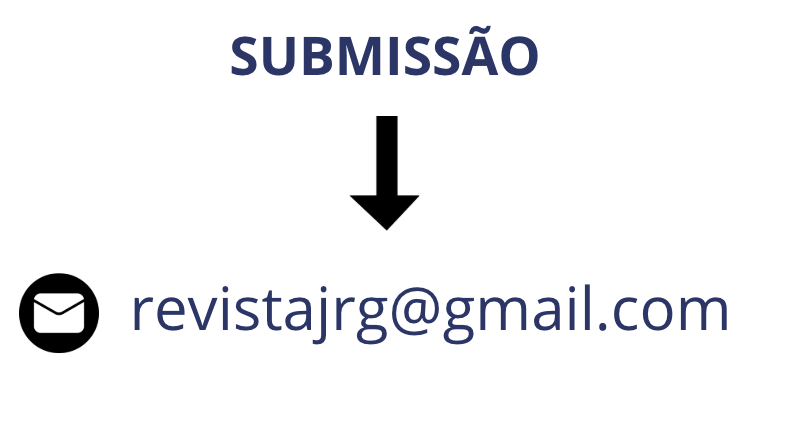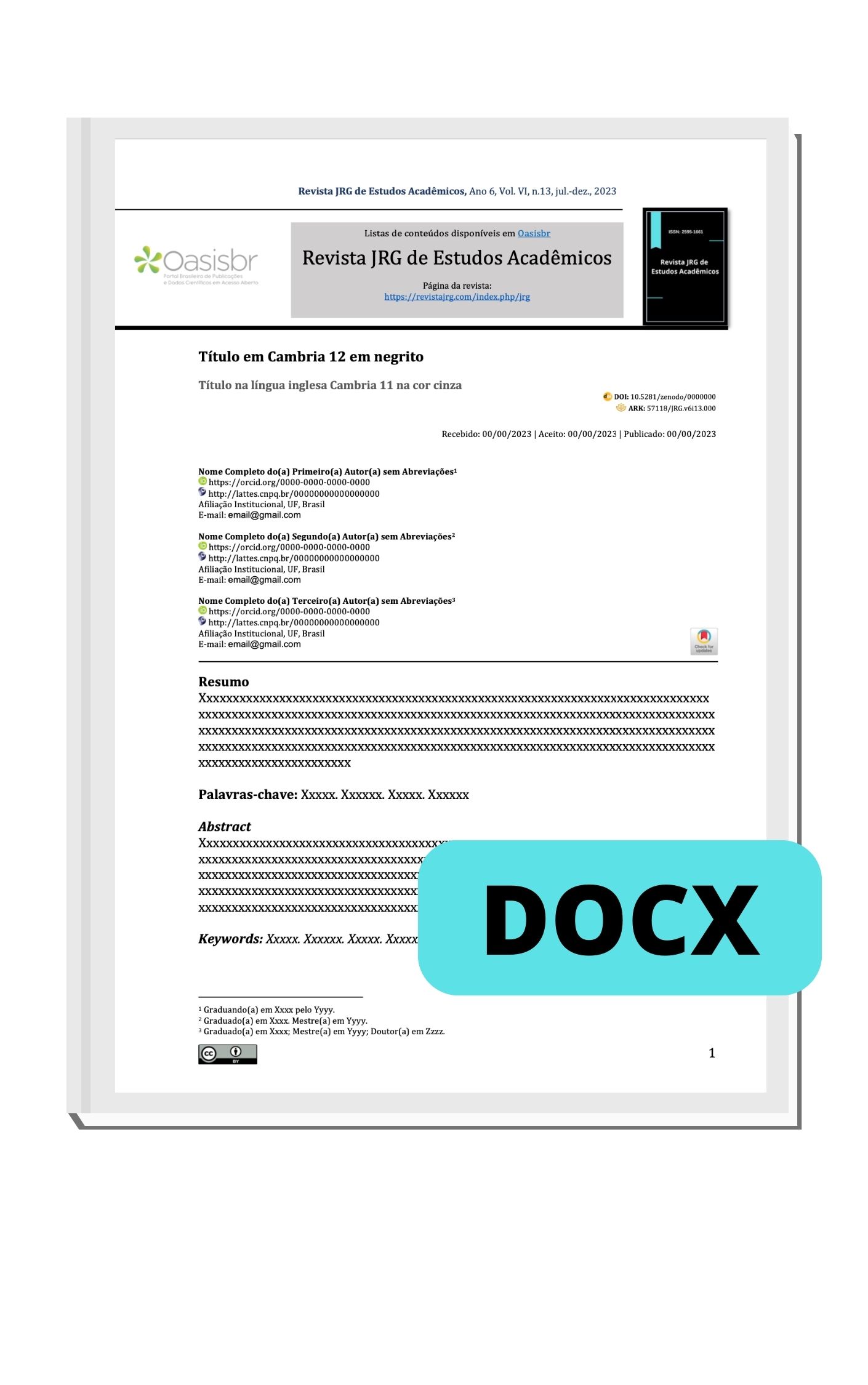The harm of using eletronic screens in childhood: an integrative literature review
DOI:
https://doi.org/10.55892/jrg.v7i14.705Keywords:
Electronic screens. Child development. Infancy.Abstract
Introduction: The incorporation of technology into children's routine originated the so-called cyber-childhood, bringing with it advantages, as well as harms that must be debated, thus, questions arise about adequate screen time and the consequences of exacerbated use. Objective: To analyze the scientific literature on the harmful effects of using electronic screens in childhood. Methodology: This is an integrative literature review, where the Health Sciences Descriptors (DeCS/MeSH) were used: screen time; child and child development combined with the Boolean AND operator. The research was carried out in July 2023, in the databases: Medical Literature Analysis and Retrievel System Online (MEDLINE) Latin American Literature of Health Sciences (LILACS) and PubMed, in the period from 2018 to 2023. Results: The final selection had 17 articles that met the inclusion and exclusion criteria determined and were categorized into: year of publication; journal title; article title; language and main results. Discussion: The analysis of the selected articles showed that the repercussions caused by exposure to screens are presented in different ways, paying attention to: language development, cognition, socio-emotional aspects, attention, eating habits, sleep, school performance, Body Mass Index, among others. It also brings co-visualization as an interactive means of exposure to the screen. Final considerations: The study revealed an association between screen use time and consequent harm that clearly affects the neuropsychomotor development of these children, relating to sedentary lifestyle, introversion, poor sleep quality and the manifestation of diseases such as obesity, depression and anxiety.
Downloads
References
ADAMS, Carin; KUBIN, Laura; HUMPHREY, John. Screen technology exposure and infant cognitive development: A scoping review. Journal of Pediatric Nursing, 2022.
ANDRADE, Bianca Mendonça et al. Os fatores associados à relação entre tempo de tela e aumento de ansiedade em crianças e adolescentes durante a pandemia de COVID-19: uma revisão integrativa. Research, society and development, v. 11, n. 8, p. e8511830515-e8511830515, 2022.
BRASIL. Lei 8.069, de 13 de julho de 1990. Dispõe sobre o Estatuto da Criança e do Adolescente e dá outras providências. Diário Oficial da União, Brasília, 16 jul. 1990.
COST, Katherine T. et al. Patterns of parent screen use, child screen time, and child socio‐emotional problems at 5 years. Journal of Neuroendocrinology, p. e13246, 2023.
DE SOUZA, Sonimar; MARQUES, Kelin Cristina; REUTER, Cézane Priscila. Tempo de tela acima das recomendações em crianças e adolescentes: análise dos fatores nutricionais, comportamentais e parentais associados. Journal of Human Growth and Development, v. 30, n. 3, p. 363, 2020.
GARCÍA, Sandra V.; DIAS DE CARVALHO, Tatiana. El uso de pantallas electrónicas en niños pequeños y de edad preescolar. Arch Argent Pediatr, v. 120, n. 5, p. 340-345, 2022.
GASTAUD, Luiza Morrone et al. Screen time: Implications for early childhood cognitive development. Early Human Development, v. 183, p. 105792, 2023.
GAVOTO, Leticia. Asociación entre el tiempo de exposición a pantallas y rendimiento en una prueba de tamizaje de desarrollo infantil. Evidencia, actualizacion en la práctica ambulatoria, v. 23, n. 1, p. e002025-e002025, 2020.
GONDIM, Ellen Cristina et al. Influências do uso de telas digitais no desenvolvimento social na primeira infância: estudo de revisão [Influences of digital screen use on early childhood social development: review study][Influencias de la utilización de pantallas digitales en el desarrollo social de la primera infancia: estudio de revisión]. Revista Enfermagem UERJ, v. 30, n. 1, p. 67961, 2022.
JOURDREN, Marie; BUCAILLE, Aurélie; ROPARS, Juliette. The impact of screen exposure on attention abilities in young children: a systematic review. Pediatric Neurology, 2023.
LIN, Yumin et al. Relationships between screen viewing and sleep quality for infants and toddlers in China: A cross-sectional study. Frontiers in Pediatrics, v. 10, p. 987523, 2022.
MADIGAN, Sheri et al. Associations between screen use and child language skills: a systematic review and meta-analysis. JAMA pediatrics, v. 174, n. 7, p. 665-675, 2020.
MORAWSKA, Alina; MITCHELL, Amy E.; TOOTH, Leigh R. Managing Screen Use in the Under-Fives: Recommendations for Parenting Intervention Development. Clinical Child and Family Psychology Review, p. 1-14, 2023.
NAGATA, Jason M. et al. Screen Time and Obsessive-Compulsive Disorder Among Children 9–10 Years Old: A Prospective Cohort Study. Journal of Adolescent Health, v. 72, n. 3, p. 390-396, 2023.
NOBRE, Juliana Nogueira Pontes et al. Fatores determinantes no tempo de tela de crianças na primeira infância. Ciência & saúde coletiva, v. 26, p. 1127-1136, 2021.
OLIVEIRA, Anna Laura Silva et al. Os impactos do uso de telas no neurodesenvolvimento infantil. RESU–Revista Educação em Saúde: V9 Suplemento, v. 3, 2021.
PAULICH, Katie N. et al. Screen time and early adolescent mental health, academic, and social outcomes in 9-and 10-year old children: Utilizing the Adolescent Brain Cognitive Development℠(ABCD) Study. PloS one, v. 16, n. 9, p. e0256591, 2021.
RAI, Jasmine et al. Patterns of preschool children’s screen time, parent–child interactions, and cognitive development in early childhood: a pilot study. Pilot and Feasibility Studies, v. 9, n. 1, p. 39, 2023.
ROCHA, Hermano Alexandre Lima et al. Screen time and early childhood development in Ceará, Brazil: a population-based study. BMC public health, v. 21, p. 1-8, 2021.
Sociedade Brasileira de Pediatria (SBP). Saúde da Criança e Adolescentes na Era Digital. Manual de Orientação Departamento de Adolescência: SBP; 2016.
SOUZA, Sonimar de; MARQUES, Kelin Cristina; REUTER, Cézane Priscila. Screen time above recommendations in children and adolescents: analysis of the associated nutritional, behavioral and parental factors. Journal of Human Growth and Development, v. 30, n. 3, p. 363-370, 2020
TEIXEIRA, Alcylanna Nunes; LÔBO, Karla Rossana Gomes; DUARTE, Ana Teresa Camilo. A Criança e o ambiente social: aspectos intervenientes no processo de desenvolvimento na primeira infância. ID on line. Revista de psicologia, v. 10, n. 31, p. 114-134, 2016
ZHANG, Zhiguang et al. Associations between the child care environment and Children’s in-care physical activity and sedentary time. Health Education & Behavior, v. 48, n. 1, p. 42-53, 2021.
ZHAO, Jin et al. Association between screen time trajectory and early childhood development in children in China. JAMA pediatrics, v. 176, n. 8, p. 768-775, 2022.











































